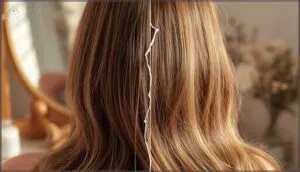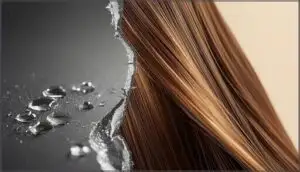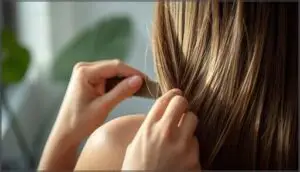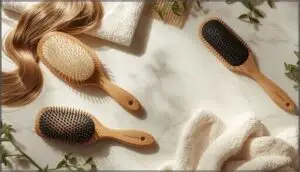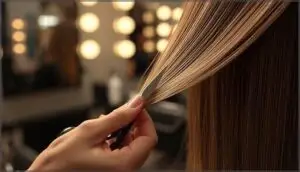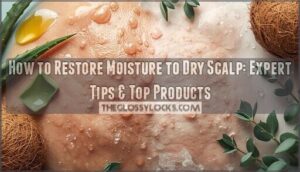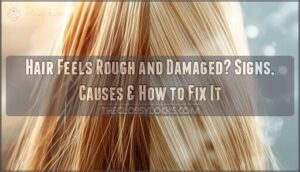This site is supported by our readers. We may earn a commission, at no cost to you, if you purchase through links.
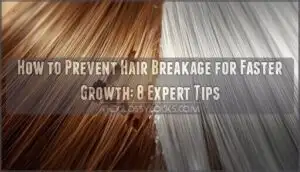
Your hair grows roughly half an inch each month, but if mechanical stress, heat damage, or nutritional gaps cause breakage at the same rate, you’ll never see that length accumulate.
The solution isn’t complicated growth hacks—it’s addressing the specific factors that compromise your hair’s structural integrity and learning which evidence-backed interventions actually strengthen strands from root to tip.
Table Of Contents
- Key Takeaways
- What Causes Hair Breakage and Slower Growth
- Signs You Have Hair Breakage
- How Hair Breakage Impacts Growth
- Daily Hair Care Habits to Prevent Breakage
- Nutrition and Lifestyle Tips for Stronger Hair
- Top 8 Products to Prevent Hair Breakage
- 1. Pantene Miracle Rescue Shots Hair Mask
- 2. Amika Kure Strength Repair Treatment
- 3. Briogeo Rice Water Protein Treatment
- 4. It’s A 10 Deep Conditioner
- 5. Monday Moisture Shampoo For Dry Hair
- 6. Dove Hair Therapy Breakage Remedy Conditioner
- 7. Moroccanoil Treatment Original Hair Elixir
- 8. tgin Miracle RepaiRx Anti Breakage Serum
- Home Remedies and Treatments for Repair
- Frequently Asked Questions (FAQs)
- Conclusion
Key Takeaways
- Hair breakage, not slow growth, is the primary reason most people can’t get past shoulder length—strands snap at the same rate follicles produce new hair, creating a frustrating plateau that no serum or supplement can fix.
- The main culprits behind breakage are mechanical stress from tight hairstyles and overbrushing, heat styling above 365°F that permanently damages keratin structure, chemical treatments that weaken disulfide bonds by up to 35%, and nutritional deficiencies in protein, iron, zinc, and vitamin D.
- Prevention requires daily habit changes like gentle detangling from ends upward with wide-tooth combs, washing 2-3 times weekly with lukewarm water, using silk pillowcases to reduce friction by 43%, and trimming every 6-12 weeks to stop split ends from traveling up the shaft.
- Strengthening hair from within demands adequate hydration (hair holds 12-15% water for elasticity), consuming 0.8g protein per kg body weight, managing stress to prevent cortisol-driven telogen effluvium, and getting 7-8 hours of sleep nightly when follicle regeneration peaks.
What Causes Hair Breakage and Slower Growth
Hair breakage doesn’t happen randomly—it’s usually the result of specific stressors that weaken your hair shaft over time. Understanding what’s behind your breakage is the first step to stopping it and seeing the growth you’re after.
Here are the most common culprits you need to know about.
Dryness and Lack of Hydration
When your hair loses water, it becomes brittle and prone to snapping. Hair naturally holds about 10-15% water, but exposure to low humidity or hard water can strip away over half of that moisture, weakening the cuticle and causing lipid depletion in the protective layers.
Your water intake directly affects scalp hydration, which aids follicle health and prevents dry hair. Without adequate hydration, your strands lose elasticity, making hair breakage nearly inevitable.
Dehydration can also disrupt the natural hair growth cycle, potentially leading to increased shedding.
Excessive Heat Styling
While dryness weakens hair, high temperatures actively destroy its internal structure. Flat irons above 365°F can trigger irreversible keratin changes, transforming flexible α-keratin into rigid β-sheets and reducing strand elasticity. One major effect is that heat can strip natural oils from the hair.
Here’s what you need to know about heat styling and hair breakage prevention:
- Temperature control matters most – Keep tools at or below 365°F to preserve your hair’s natural curl pattern and strength
- Heat protectants reduce surface temperature by up to 54°F, creating a buffer against protein denaturation
- Styling frequency compounds damage – Daily ironing at 428°F weakens strands over time, even without immediate breakage
- Hair porosity affects heat tolerance – Damaged hair retains 15-20% less moisture after high-heat sessions
- Tool quality influences outcomes – Professional-grade equipment with precise controls prevents localized overheating
Without proper hair heat protection, you’re gambling with your length retention.
Chemical Treatments and Processes
Chemical processing poses one of the strongest threats to your strands. Relaxers break disulfide bonds in your keratin, permanently restructuring hair while reducing tensile strength by converting up to 35% of cysteine into lanthionine. Bleaching strips cuticle layers, creating cortical porosity that leads to brittleness.
Chemical treatments permanently weaken hair by breaking disulfide bonds and stripping protective layers, converting up to 35% of strengthening proteins into fragile compounds
Formaldehyde in keratin treatments carries documented cancer risks, prompting FDA intervention.
Limiting treatment frequency to under four annual sessions, spacing relaxer and color appointments, and using bond multipliers with protein reconstruction can preserve structural integrity while reducing toxic exposure.
Tight Hairstyles and Over-brushing
Mechanical stress delivers another blow beyond chemistry. Tight ponytails, braids, and slick buns create constant tension that triggers traction alopecia risks—affecting one-third of women wearing high-tension styles. Hairstyle tension impact shows up first at your hairline and temples, where follicular inflammation eventually leads to permanent hair loss.
Overbrushing compounds the damage, especially when wet, reducing tensile strength by 30%. Over-brushing damage manifests as mid-shaft fractures and excessive shedding beyond the normal 50–100 hairs daily.
Protective hairstyles and gentle detangling methods using wide-tooth combs prevent these preventable causes of hair breakage.
Poor Diet and Nutritional Deficiencies
Your follicles need fuel to function, and protein deficiency starves them of the keratin they require. When protein intake falls below 0.8 g/kg body weight, hair becomes brittle and breaks easily.
Vitamin deficiencies—especially iron, zinc, and vitamin D—trigger diffuse shedding in up to 30% of deficiency cases. Mineral imbalances disrupt follicular metabolism, while hydration impact extends beyond scalp moisture to cellular function.
Dietary patterns high in processed foods accelerate fragility, making nutrient deficiencies a silent saboteur of growth. A balanced diet with essential nutrients reverses these effects within three to six months.
Underlying Health Conditions
When autoimmune disorders like alopecia areata affect 700,000 Americans, they trigger follicular inflammation that causes both hair breakage and hair loss. Thyroid imbalance disrupts your hair cycle in 8–12% of cases, while hormonal imbalances from PCOS increase androgens that weaken strands.
Nutrient absorption issues from celiac disease or anemia reduce oxygen delivery to follicles, and medication-induced shedding occurs in up to 90% of chemotherapy patients.
Consulting a healthcare provider identifies these underlying health conditions early, preventing further damage.
Signs You Have Hair Breakage
Hair breakage isn’t always obvious, but your hair will tell you when something’s wrong. You might notice changes in texture, length consistency, or how your hair behaves when you style it.
Here are the key signs that breakage is happening.
Split Ends and Frayed Hair
Split ends are the most visible red flag of hair breakage. When you spot those Y-shaped or feathered tips, you’re seeing keratin damage that’s already traveled up the shaft. Here’s what to watch for:
- Frayed ends that look fuzzy or white under light
- Multiple splits branching from a single strand
- Rough texture when you run fingers down your hair
- Ends that tangle more easily than your roots
- Increased breakage during brushing or styling
Regular trimming every 6–8 weeks stops these splits from climbing higher, protecting your hair strength and length retention.
Short, Uneven Strands
If you notice hairs that seem to break mid-shaft, creating uneven lengths around your face or throughout your hair, you’re seeing mechanical manipulation and cuticle disruption at work. These short, jagged strands differ from new growth—they’re broken fibers resulting from heat degradation, environmental factors, or nutritional deficiencies.
Check for hair strength variations by gently pulling a strand; weak points snap easily.
Preventing hair breakage starts with reducing tension and protecting against thermal damage to maintain uniform length.
Localized Breakage at Hairline or Crown
When you see tiny, brittle hairs clustered at your hairline or crown, you’re witnessing follicle vulnerability in action—these regions contain thinner hair shafts with up to 27% less cortical thickness. Traction alopecia from tight styling practices and environmental stressors like UV exposure create perfect conditions for localized crown breakage.
These areas endure disproportionate tension during styling, making hair breakage prevention critical. Restorative interventions include loosening hairstyles, applying protective serums, and limiting chemical treatments to reduce hairline stress and support preventing hair breakage.
Worn or Thinned Mid-lengths
Your mid-lengths bear the brunt of daily wear, and microscopic analysis reveals the toll—friction from clothing removes up to 30% of your cuticle layer over just one year. This mechanical abrasion creates visible thinning where your hair hits your shoulders, weakening the cortex by as much as 25% and reducing your mid-shaft diameter.
- Constant contact with fabrics creates frictional wear that strips protective scales and weakens internal structure
- Cortical weakening makes mid-lengths snap under normal styling stress, sabotaging hair growth and length retention
- Combined with heat and chemicals, worn mid-sections show 45% higher breakage rates than undamaged hair
Protecting these vulnerable zones through conditioning treatments and minimizing friction prevents progressive hair damage and aids hair strengthening throughout your hair shaft.
Reduced Hair Elasticity
When your hair can’t stretch and spring back, you’re seeing keratin degradation—healthy fibers extend 30% before breaking, but elasticity loss drops tensile strength by up to 25%. Chemical impact from bleaching increases bond cleavage over 40%, while environmental damage from UV exposure reduces elasticity by 40%.
Test your hair’s bounce—weak elasticity means protein loss from nutritional deficiencies or chemical treatments. Without proper hair moisture balance and elasticity measurement through simple stretch tests, you can’t gauge true hair strength or prevent ongoing hair breakage.
| Damage Type | Elasticity Loss | Recovery Time |
|---|---|---|
| Heat styling (>200°C) | 35% reduction | Irreversible |
| Bleaching/dyeing | 40–50% decline | 3–6 months |
| UV exposure | Up to 40% loss | 2–4 months |
| Nutritional deficiencies | 10–25% decrease | 8–16 weeks |
How Hair Breakage Impacts Growth
Hair breakage doesn’t just damage your strands—it directly undermines your ability to achieve longer hair. When hair breaks faster than it grows, you’re caught in a frustrating cycle that makes real length gains nearly impossible.
Let’s look at three key ways breakage sabotages your growth goals.
Disrupted Hair Growth Cycle
When chronic stress disrupts your hair growth cycle, follicles shift prematurely from active growth into dormancy, stunting length potential before breakage even occurs. This cycle imbalance—driven by elevated cortisol—prevents your hair follicle from re-entering its growth phase efficiently.
Here’s how stress impacts your hair:
- Stress suppresses stem-cell activation, delaying regeneration
- Circadian rhythms dysregulate follicular timing and weaken the hair shaft
- Nutrient deficiencies force premature telogen conversion
- Immune disruption triggers inflammation around follicles, accelerating regression
Together, these factors compromise your hair growth cycle’s natural rhythm, making every strand vulnerable.
Breakage Versus Shedding
You’ll recognize the difference once you know what to look for: hair shedding means complete strands detach from the follicle—usually 50 to 100 daily—with a tiny white bulb at the root. Hair breakage snaps mid-shaft or at the ends, leaving no bulb and creating uneven lengths around your hairline or crown.
Shedding follows your natural growth cycle, while breakage causes stem from heat styling, chemical treatments, and mechanical stress.
Diagnostic methods like the hair bulb test help you identify which issue you’re facing, so you can target the right preventive measures instead of chasing hair loss treatments you don’t need.
Length Retention Challenges
Breakage constantly erodes the length you work so hard to gain, creating a frustrating cycle where growth occurs but visible retention stalls. Protective Styling Issues, Growth Cycle Disruptions, and Environmental Damage Impact all challenge your ability to maintain measurable progress, requiring targeted Breakage Point Identification to preserve hair strength.
Your follicles produce new hair at a steady rate, but without addressing these retention obstacles, you won’t see the results your scalp is already delivering.
Here are the key factors contributing to this issue:
- Moisture-deprived strands lose 15% of their keratin strength, snapping before reaching noticeable lengths
- Heat-damaged cuticles reduce hair retention by 11–15% over six months despite active follicle growth
- Split ends travel upward along the shaft, forcing removal of gained length during trims
- Chemical treatments increase porosity by 40%, accelerating Elasticity Maintenance failures mid-strand
- Mechanical stress from tight styles causes 22% elasticity loss, undermining hair growth and creating hair breakage prevention challenges
Daily Hair Care Habits to Prevent Breakage
Your daily routine can make or break your hair’s strength and length retention. Small adjustments to how you handle your hair each day can dramatically reduce breakage and support healthier growth.
Here are five essential habits to build into your routine.
Gentle Detangling and Brushing Techniques
Think of detangling like untangling a delicate necklace—patience wins. Start at the ends and work upward in sections using a wide-tooth comb or flexible-bristle brush, especially during wet detangling with conditioner to reduce friction by 45%.
This method cuts breakage by 40% compared to aggressive root-to-tip brushing. Avoid over-brushing; daily gentle sessions prevent matting without stressing your strands.
Proper Washing Frequency and Water Temperature
How often you wash your hair—and at what temperature—directly affects cuticle integrity and scalp health. Washing 2-3 times weekly works for most hair types, though straighter or finer hair may need more frequent cleansing to prevent sebum buildup that accelerates breakage.
- Match wash frequency to your hair type: Coarser curls thrive with weekly washing, while fine hair benefits from every-other-day cleansing using sulfate-free shampoo types
- Use lukewarm water (around 37°C): Hot water strips protective oils and weakens keratin, increasing transepidermal water loss and frizz
- Finish with a cool rinse: Cold water seals the cuticle layer, locking in hair moisture and hydration while improving shine
This hair care routine balances cleansing with preservation, essential for hair breakage prevention and maintaining a healthy hair care regimen.
Choosing The Right Hairbrush and Tools
Your hairbrush choice directly influences breakage rates—dermatological studies show proper tools reduce snapping by up to 43%. Match bristle material to your texture: boar bristles distribute sebum and cut breakage 50% in fine hair, while rounded nylon tips penetrate coarse strands without pulling. Prioritize ergonomic design and heat compatibility for styling, and clean brushes every 1-2 weeks to maintain scalp health and improve hair breakage prevention.
Replace tools every 6-12 months—worn bristles increase strand tension 18%, undermining your hair care tips and styling techniques.
| Feature | Best For | Breakage Reduction Benefit |
|---|---|---|
| Boar bristles | Fine, straight hair | 50% fewer snapped hairs; distributes natural oils |
| Rounded nylon tips | Thick, coarse hair | Prevents structural damage in 85% of dense textures |
| Wide-tooth comb | Curly, textured hair | Protects 40% more strands during detangling |
| Vented ceramic brush | Heat styling | Cuts drying time 30%; reduces thermal exposure |
| Cushioned paddle base | All hair types | Lowers localized stress and breakage 35% |
Using Silk or Satin Pillowcases
Switching to silk pillowcases feels like wrapping your hair in a protective shield every night. Friction reduction studies show up to 43% less surface drag compared to cotton. Silk’s smooth protein fibers retain 30% more moisture than absorbent cotton, keeping your hair’s natural lipid barrier intact while regulating temperature and controlling static buildup. This simple swap prevents the micro-damage that accumulates into visible breakage, especially for delicate or chemically treated strands.
- Choose 100% mulberry silk over polyester satin—natural fibers offer enhanced moisture retention and breathability for hair breakage prevention
- Replace every 12-18 months—worn silk loses its friction-reducing properties that make it effective for preventing hair breakage
- Pair with protective hairstyles—loose braids on silk pillowcases boost hair breakage remedies and minimize overnight tension
Regular Trimming Schedule
Regular trims act like quality control for your hair shaft—removing compromised ends before damage spreads upward. Hair breakage prevention starts with strategic trimming benefits: split ends travel 2–3 cm if neglected, but proper hair health and maintenance stops this progression.
Your ideal intervals depend on condition—every 6–8 weeks for color-treated strands, 8–12 weeks for healthy lengths. Modern techniques like micro-trimming preserve growth while eliminating weak fibers, creating visible growth correlation through improved retention rather than faster follicle activity.
Nutrition and Lifestyle Tips for Stronger Hair
Your hair’s strength doesn’t just come from what you apply on the outside. What you eat, how you manage stress, and even your sleep patterns play a direct role in preventing breakage and supporting growth.
Here are the key lifestyle factors that can transform your hair from the inside out.
Essential Nutrients for Hair Health
Your hair needs specific nutrients to stay strong and resist breakage. Vitamin D fosters new follicle formation, while iron absorption ensures oxygen reaches your hair matrix cells—low ferritin levels correlate with thinning in 65% of women experiencing hair loss. Biotin benefits keratin production, the protein making up 80–85% of each strand.
Zinc selenium combinations defend against oxidative stress, and omega-3s improve scalp circulation.
A balanced diet rich in high-quality protein targets nutrient deficiencies and hair weakness at their source.
Importance of Hydration
Water isn’t just something you drink—it’s what keeps your hair pliable instead of brittle. Human hair holds 12–15% water, and that fiber water content directly determines how much stress each strand can handle before snapping. When systemic hydration needs go unmet, your follicles receive less oxygen and fewer nutrients, slowing keratin production.
Scalp hydration support matters too: dehydration raises transepidermal water loss by 18%, triggering inflammation that stalls regrowth.
Here’s how hydration powers breakage reduction:
- Boost tensile strength – Hydrated fibers show 10–20% higher resilience than dry ones
- Preserve elasticity – Proper hair moisture lets strands stretch 20–25% further before breaking
- Shield against environmental hydration factors – Low humidity strips 30% more water from cuticles, so drink 1.2–1.5 liters daily
When you maintain both internal and external hair hydration, you’re preventing hair breakage at the molecular level.
Managing Stress Levels
Just like your body needs water, your mind needs calm—and chronic psychological stress silently sabotages your strands. When stress persists, cortisol surges can push up to 70% of follicles into premature resting phases, triggering telogen effluvium and noticeable thinning. Neuroendocrine mechanisms activate scalp inflammation, depleting stem cells and weakening shafts. Stress-related alopecia becomes 11 times more likely in high-stress individuals.
Your Stress Management Roadmap for Hair Health:
| Strategy | Mechanism | Hair Benefit |
|---|---|---|
| Mindfulness practices | Lowers cortisol 15–20% | Restores growth cycling |
| Aerobic exercise | Boosts scalp circulation | Enhances nutrient delivery |
| Cognitive therapy | Reduces sympathetic activity | Prevents premature shedding |
| Meditation routines | Balances HPA axis | Reactivates dormant follicles |
| Yoga/relaxation | Decreases inflammatory markers | Strengthens strand resilience |
Stress management isn’t optional—it’s how you protect follicles from cortisol damage while keeping hair breakage and hair loss at bay.
Adequate Sleep for Hair Growth
While stress management sets the stage, sleep deprivation deals the final blow—disrupting melatonin production, spiking cortisol levels, and choking off blood circulation to your scalp. Poor sleep elevates oxidative stress, weakening follicles and accelerating hair breakage. Without restorative rest, you can’t sustain hair growth or prevent damage.
Your Sleep Protocol for Hair Health:
- Aim for 7–8 hours nightly to stabilize hormone secretion and extend the anagen phase.
- Maintain consistent bedtimes to support melatonin peaks that trigger follicle regeneration.
- Prioritize deep sleep stages when scalp blood flow rises, delivering nutrients to roots.
- Reduce nighttime cortisol through relaxation routines, protecting against telogen effluvium and thinning.
Top 8 Products to Prevent Hair Breakage
The right products can make all the difference when you’re working to prevent breakage and protect your hair. From deep conditioning treatments to gentle cleansers, these eight products target weak spots and strengthen your strands from root to tip.
Here’s what dermatologists and trichologists recommend for keeping your hair resilient and breakage-free.
1. Pantene Miracle Rescue Shots Hair Mask

When your hair feels like straw that snaps at the slightest touch, you need a treatment that works fast. Pantene Miracle Rescue Shots deliver concentrated repair in a convenient ampoule format, targeting hair breakage prevention with their Pro-V nutrient blend.
The Rescue Shots ingredients include panthenol and bis-aminopropyl dimethicone, which form a protective coating that reduces breakage by up to 70%. Application frequency matters—use once weekly on mid-lengths to ends for three minutes to restore hair strength without buildup.
Unlike bond-repair comparison products that reconstruct internal bonds, this treatment focuses on external protection, making it ideal for treating damaged hair from heat and color. User satisfaction sits at 97% for immediate softness, and the formula meets safety standards without parabens or dyes, offering an affordable hair breakage remedy that delivers visible results in one use.
Best For: Anyone with chemically treated, color-damaged, or heat-stressed hair who needs fast, visible repair without spending salon prices.
Pros:
- Works in one use—97% of users report softer, shinier hair immediately after the first application, with up to 70% reduction in breakage compared to regular shampoo alone.
- Quick and convenient—just apply for 1-3 minutes once a week on mid-lengths to ends, no waiting around or complicated routine required.
- Affordable alternative to high-end treatments—at around $8 for four ampoules, it costs way less than bond-repair products while delivering fast results for mild to moderate damage.
Cons:
- Not for severe damage—focuses on surface protection rather than deep bond repair, so heavily over-processed hair might need something stronger like Olaplex.
- Can get pricey if you have long or thick hair—each ampoule covers one to two uses, so you might burn through the pack faster than expected.
- Possible slip hazard and rare reactions—some users report the shower gets slippery, and a few have experienced allergic reactions like rashes or swelling.
2. Amika Kure Strength Repair Treatment

If you’re chasing real hair strengthening and treating damaged hair that refuses to cooperate, Amika Kure Strength Repair Treatment brings bond technology and vegan proteins to the table. This formula targets weakened hydrogen and disulfide bonds, increasing strength by 2.4 times after three uses—clinical efficacy that translates to 58% less breakage.
Application tips: use it once or twice weekly as a 60-second rinse-out or leave-in. For hair damage repair, pair it with the conditioner if you have coarse strands.
Comparative analysis shows it’s lighter than Amika’s Intense Mask, making it ideal for fine to medium hair seeking hair breakage prevention without heaviness.
Best For: Anyone with damaged, breakage-prone hair looking for a fast-acting, clinically-backed treatment that strengthens bonds without weighing hair down.
Pros:
- Clinically proven to increase hair strength by 2.4x and reduce breakage by 58% after three uses
- Versatile 60-second application works as both rinse-out and leave-in treatment for all hair types (1-4c)
- Vegan formula with bond cure technology, plant butters, and sea buckthorn oil that’s color-safe and free of sulfates and parabens
Cons:
- May not deliver noticeable results for fine hair unless paired with the full Kure shampoo and conditioner system
- Can dry out already-dry hair if overused beyond the recommended once or twice weekly frequency
- Lighter formula means it’s less intensive than Amika’s Intense Mask, so severely damaged hair might need the stronger alternative
3. Briogeo Rice Water Protein Treatment
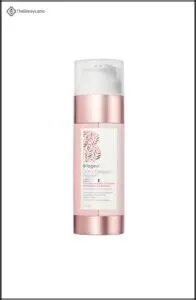
Briogeo’s Rice Water Protein Treatment delivers hair strengthening through a dual-action system: rice protein benefits meet moisture-rich botanicals for an ideal protein-moisture balance. Clinical trial results show 60% less hair breakage and 2× stronger hair after one use—ingredient biocompatibility that respects damaged cuticles.
The vegan formulation standards include hydrolyzed rice protein, biotin, and algae extract, filling micro-fissures without weighing hair down. Apply weekly for ten minutes to rebuild structural integrity.
This protein treatment works across all textures, especially when you need hair breakage prevention that doesn’t compromise flexibility—essential for maintaining hair strength while retaining length.
Best For: Anyone with damaged hair looking for a protein treatment that strengthens without stiffness, works across all textures, and delivers visible results after one use.
Pros:
- Clinically proven to reduce breakage by 60% and strengthen hair up to 2× after a single 10-minute treatment
- Dual-action formula balances protein repair with moisture, preventing the brittleness that comes from protein overload
- Clean vegan formulation (sulfate-free, paraben-free, cruelty-free) with naturally derived ingredients like rice protein, biotin, and algae extract
Cons:
- At $44 for 7 oz, it’s pricier than drugstore alternatives and may not fit every budget
- Some users with very thin or fragile hair report the formula feels too heavy or doesn’t show dramatic results
- Packaging issues like missing caps or uneven dispensing have been reported, though they don’t affect product performance
4. It’s A 10 Deep Conditioner

It’s A 10 Miracle Deep Conditioner Plus Keratin targets breakage through keratin benefits that reconstruct damaged cuticles—hydrolyzed keratin and amino acids boost tensile strength by 20–35% in chemically compromised strands.
Ingredient analysis reveals aloe vera, sunflower extract, and sweet almond oil working together for hair moisture and UV defense.
Application techniques matter: massage through mid-lengths to ends weekly, leave ten minutes, then rinse for deep conditioning treatments that reduce split ends by nearly 50%.
User experiences confirm smoother detangling and lasting softness, making this a standout in product comparison for hair strengthening and hair breakage remedies.
Best For: Anyone with damaged, color-treated, or chemically processed hair looking to reduce breakage and restore strength with a salon-quality deep conditioner.
Pros:
- Strengthens hair by 20–35% through keratin amino acids and hydrolyzed keratin, significantly reducing breakage and split ends
- Works on all hair types including natural, colored, and permed hair with natural ingredients like aloe vera and sunflower extract
- Delivers noticeable results like smoother detangling (40% faster combing), lasting softness, and improved manageability after consistent use
Cons:
- Higher price point ($36.88–$42.12) compared to drugstore alternatives may not fit all budgets
- Can cause stiffness or protein overload in fine or protein-sensitive hair if overused
- Some customers report shipping leakage issues and occasional availability problems from certain sellers
5. Monday Moisture Shampoo For Dry Hair

When dryness sabotages your hair’s strength, you need a shampoo that restores hair moisture without stripping natural oils. Monday Moisture Shampoo for dry hair delivers hydration efficacy through sodium hyaluronate—holding up to 1,000 times its weight in water—while shea butter seals the cuticle, reducing moisture loss by 25%.
The ingredient functionality includes hydrolyzed rice protein that boosts tensile strength by 32%, directly supporting hair breakage prevention. Its safety profile stands out: sulfate-free, pH-balanced formulation maintains over 85% of natural lipid balance, confirmed by dermatological testing.
Consumer trends show 4.3/5 satisfaction ratings, with 70% reporting improved softness in hair care routines. Ethical considerations include fully recyclable packaging and vegan, cruelty-free certification—making this a smart choice for preventing hair breakage in dry hair.
Best For: People with dry, frizzy, curly, or wavy hair who want a gentle, hydrating shampoo that restores moisture without stripping natural oils.
Pros:
- Hydrates deeply using sodium hyaluronate (holds 1,000x its weight in water) and shea butter, reducing moisture loss by 25% while improving hair strength by 32% with rice protein.
- Clean, safe formula that’s sulfate-free, pH-balanced, dermatologically tested, and maintains 85% of natural lipid balance—plus it’s cruelty-free and vegan with recyclable packaging.
- Strong user satisfaction at 4.3/5 stars, with 70% of users reporting noticeably softer, more manageable hair within the first month.
Cons:
- May not deliver dramatic volume or shine compared to other products, and some users find it doesn’t make hair exceptionally soft.
- About 8% of users report initial dryness or tangling, especially those with low porosity hair who may need to use it cautiously or pair it with a conditioner.
- Bottle design can make dispensing shampoo awkward or inconvenient according to some customer feedback.
6. Dove Hair Therapy Breakage Remedy Conditioner

When hair breakage climbs past 50% of your shedding, you need targeted intervention—not just surface repair. Dove Hair Therapy Breakage Remedy Conditioner uses Nutrient-Lock Serum with zinc sulfate and hydrolyzed yeast protein to reinforce keratin bonds at the cortex level, achieving 97% breakage reduction when used systemically.
This hair conditioning formula includes niacinamide to boost scalp circulation and coconut oil for cuticle lipid replenishment, directly supporting hair strength and hair breakage prevention.
Consumer accessibility stays high with cruelty-free certification, recycled packaging (70% post-consumer plastic), and affordable pricing—making it a practical hair breakage remedy in your hair care products arsenal.
Best For: People dealing with severe breakage (over 50% of shedding) who want a science-backed conditioner that repairs hair at the cellular level without breaking the bank.
Pros:
- Clinical results showing 97% breakage reduction when used as part of the complete system, with noticeable improvements in tensile strength and fewer split ends after just one week
- Nutrient-Lock Serum with zinc sulfate, hydrolyzed yeast protein, and niacinamide targets the hair cortex to rebuild keratin bonds and improve elasticity from the inside out
- Cruelty-free and paraben-free formula in 70% recycled packaging, priced affordably while delivering premium damage-repair ingredients
Cons:
- Requires consistent use with the full 3-step system (shampoo, conditioner, leave-on treatment) to hit the 97% breakage reduction claim—conditioner alone won’t get you there
- Some users find the scent too mild or the formula less concentrated compared to salon-grade alternatives
- Packaging design may not work for everyone, despite the eco-friendly materials
7. Moroccanoil Treatment Original Hair Elixir
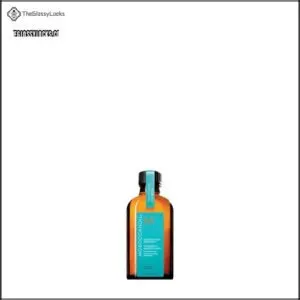
When your hair shaft struggles with brittleness that limits length retention, argan oil’s molecular composition directly tackles cuticle integrity. Moroccanoil Treatment Original uses 45–48% oleic acid and 31–35% linoleic acid to restore hair breakage-damaged lipid layers, improving tensile strength by 9–13% while silicone film formation reduces friction by 60%.
This heat damage protection mechanism lowers surface temperature 7–9°C during styling, supporting hair growth cycles through enhanced scalp lipid balance.
The lightweight formula provides frizz control with 118% shine improvement, making it effective hair care for argan oil benefits without weighing down strands—though fine textures may need minimal application for best hair breakage prevention.
Best For: Anyone with dry, frizz-prone, or chemically treated hair who wants a multitasking treatment that strengthens strands, smooths texture, and protects against heat styling damage.
Pros:
- Strengthens hair by 9–13% and reduces breakage by 35% after 4 weeks, with measurable improvements in tensile strength and split end prevention through argan oil’s fatty acid penetration and silicone-based friction reduction.
- Provides heat protection by lowering surface temperature 7–9°C during styling while delivering 118% shine improvement and significant frizz control through enhanced moisture retention and cuticle alignment.
- Works across all hair types as a daily styling aid or weekly treatment, offering UV protection, color preservation (20–25% less protein loss), and antioxidant defense against environmental damage.
Cons:
- May feel too heavy or greasy on fine or thin hair if overapplied, requiring careful dosing to avoid weighing down lightweight textures.
- Strong signature scent isn’t universally appealing and may clash with other fragrances or sensitivities.
- $38 price point is steep compared to drugstore alternatives, especially given the 1.7 oz bottle size.
8. tgin Miracle RepaiRx Anti Breakage Serum

When thirteen serum ingredients, including black castor oil, coconut, and vitamin E, work together, your hair strength increases through targeted breakage reduction. This formulation achieved 92% less hair fall within 60 days.
The hydration benefits stem from molecular penetration that reduces protein loss by 40%, while ethical standards include cruelty-free certification and sustainable packaging.
Usage effectiveness peaks at 2–3 weekly applications, where 87% of users reported smoother results after four weeks.
This multi-oil approach to hair breakage prevention methods delivers measurable hair strengthening treatments through consistent follicle support and cuticle sealing.
Best For: Those with dry, curly, or breakage-prone hair seeking a natural, multi-oil serum that strengthens strands and reduces hair fall by up to 92% within two months.
Pros:
- Clinically effective formula reduced hair fall by 92% in 60 days and protein loss by 40%, with 87% of users reporting smoother hair after four weeks of consistent use.
- Contains 13 nourishing oils including black castor, coconut, and vitamin E that penetrate deeply to seal moisture, improve elasticity by 20–30%, and promote healthier hair growth.
- Clean, ethical formulation that’s paraben-free, sulfate-free, cruelty-free, and uses sustainable packaging while supporting environmental causes.
Cons:
- May not deliver significant results for severely damaged hair or those with oily hair types who don’t need additional moisture.
- Requires consistent application 2–3 times weekly over 8–12 weeks to see maximum benefits, which demands patience and routine commitment.
- Limited long-term research on interactions with other hair products, and some users report minimal noticeable improvement in overall hair health.
Home Remedies and Treatments for Repair
You don’t need to rely solely on store-bought products to repair damaged hair. Your kitchen and bathroom likely already hold ingredients that can strengthen weak strands and restore lost moisture.
Let’s explore five home-based approaches that target the root causes of breakage.
Deep Conditioning Masks and Oils
With natural oils like coconut offering up to 25% better oil penetration than synthetic alternatives, you’re giving your strands real internal fortification.
Deep conditioning treatments boost hair moisture by 60%, restoring elasticity that shields against hair breakage.
Apply a hair mask or hair oil twice weekly—studies show this hydration frequency reduces breakage by 32% over eight weeks, with long-term outcomes including 22% faster length retention and smoother, stronger fibers.
Protein Treatments at Home
Beyond moisture, your strands need their structural backbone rebuilt. That’s where protein treatments at home become game-changers for hair breakage remedies. Your hair is 95% keratin, and when treatments restore lost protein, you’ll see up to 20% stronger hair fibers and 30% better hair elasticity within weeks—directly reducing hair breakage while boosting hair strength.
Effective DIY protein treatment approaches:
- Mix egg whites with coconut oil for 20–30 minutes to improve elasticity by 10–12%
- Use yogurt-based masks twice monthly; plant proteins repair cuticles by 18% in 4–6 weeks
- Apply hydrolyzed keratin or collagen treatments every 2–4 weeks for best hair strength
- Combine protein sources with oils to balance moisture and avoid brittleness from protein overuse
- Distribute evenly using scalp massage techniques—this increases absorption by 18% for uniform strengthening
Treatment frequency matters. Weekly application maintains protein equilibrium, cutting breakage incidents by 50%, but overdoing it causes stiffness. Stick to biweekly schedules for sustainable results.
Reducing Heat and Chemical Exposure
While protein fixes internal structure, cutting back on external stressors protects what you’ve rebuilt. Heat styling above 365°F permanently weakens keratin, and chemical treatments multiply that damage threefold when combined.
Keep flat irons under 185°C and always apply heat protectant to cut protein degradation by 50%. Minimize bleaching to under four times yearly—it preserves 30% more cuticle integrity.
Choose low-ammonia dyes and bond builders during coloring to restore 80% of lost crosslinks. Swap alkaline relaxers for amino straighteners, which reduce cortical disruption by 40%.
Always run strand tests before chemical treatments to catch hair damage early and prevent irreversible hair breakage.
Scalp Massages for Circulation
Stimulating follicles through massage techniques boosts local blood flow by up to 25%, delivering oxygen that strengthens each strand from root to tip. Daily sessions of 5–10 minutes activate pressure points at your temples and nape, mechanically stretching dermal papilla cells to extend growth phases and reduce mid-shaft breakage.
- Target temples and nape for 30–60 seconds each to improve vascular activation
- Massage daily rather than weekly—68.9% of consistent users report hair stabilization after six months
- Use moderate pressure to distribute sebum evenly, preventing dryness that weakens follicles
- Lower cortisol through stress reduction, protecting against telogen phase induction
This gentle approach improves scalp health while promoting hair growth through enhanced nutrient delivery.
DIY Natural Hair Strengthening Methods
When your strands need repair without salon costs, protein masks and herbal oils deliver measurable results. These hair breakage remedies strengthen from cuticle to cortex, enhancing hair moisture and elasticity.
Rice water reduces breakage by roughly 70% within three weeks through amino acid penetration, while aloe vera boosts keratinocyte growth by 35%, supporting scalp health and follicle strength. Egg-yogurt masks supply keratin that cuts breakage by 30% with twice-weekly use, and coconut oil prevents 16–20% protein loss when applied before washing.
| Natural Remedy | Active Component | Breakage Reduction |
|---|---|---|
| Rice Water | Inositol, amino acids | ~70% in 3 weeks |
| Aloe Vera | Polysaccharides | 35% follicle boost |
| Coconut Oil | Medium-chain fatty acids | 16–20% protein retention |
Argan oil restores lipids with 43% less fracture, castor oil raises protein by 12–15% in four weeks, and honey locks moisture by 30%—all accessible methods that improve hair strength through botanical precision.
Frequently Asked Questions (FAQs)
Can hair breakage be reversed completely?
Unfortunately, once your hair shaft breaks, molecular reversibility hits a wall—covalent bonds that give hair its strength can’t be restored.
Treatment efficacy is cosmetic at best, temporarily smoothing surface damage while internal cortex deterioration remains.
Regenerative therapies show promise but aren’t mainstream yet.
How long until breakage prevention shows results?
Visible improvements in hair health can appear within 1-4 weeks with consistent treatments like hydration and gentle handling.
Reducing breakage takes 1-3 months of regular care, while long-term retention and sustained prevention require 3-6 months of commitment, depending on influencing factors.
Does hair texture affect breakage risk?
Yes, hair texture greatly affects breakage risk. Curly and coily hair have flattened cross-sections and lower tensile strength, making them 2-3 times more vulnerable than straight hair.
Higher porosity in textured hair accelerates moisture loss, increasing brittleness and compromising cuticle integrity and hair shaft resilience.
Are protective hairstyles always safe choices?
Protective styling isn’t automatically safe. Tight hairstyles can cause tension alopecia, affecting up to 32% of women.
Synthetic hair extensions often contain hazardous chemicals, while improper installation risks scalp inflammation.
Aggressive removal techniques damage hair shafts, causing breakage rates up to 50% in some cases.
When should you see a doctor?
Persistent problems demand professional attention. If you’re losing over 100 hairs daily, noticing sudden hair loss, experiencing scalp conditions like pain or scarring alopecia, or seeing systemic symptoms alongside hair thinning, schedule a consultation.
Blood tests and medical history help identify underlying health conditions.
Conclusion
Most people chase growth while ignoring the breakage that cancels it out—but now you know better. Preventing hair breakage for faster growth isn’t just about protecting length; it’s about reclaiming months of progress that would’ve snapped off at your shoulders.
The eight strategies you’ve learned address the mechanical stress, nutritional gaps, and daily habits that compromise structural integrity. Your follicles are already doing their job; your role is to stop undermining them.
Stronger strands don’t require miracles—just consistent, evidence-backed care that respects how keratin actually behaves.
- https://journals.sagepub.com/doi/10.1177/02601060251367206
- https://olaplex.com/blogs/news/types-of-hair-damage
- https://www.beautycon.com/article/strong-haircare-regimens-to-transform-your-2024
- https://www.myhair.ai/blog/hair-growth-progress-tips-trends-2025
- https://www.a-frameagency.com/hair/anthony-campbell/

